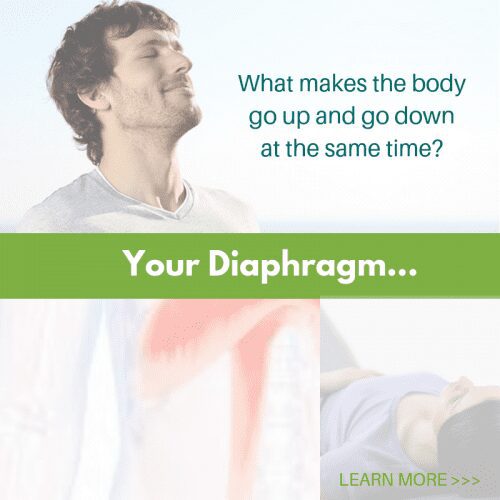The diaphragm is the fascinating and unique muscle which is most involved in your breathing. Located about two thirds of the way down your torso, it is the only muscle that attaches to the whole circumference of your body. And most muscles “insert” into bone, but the diaphragm inserts into itself! It originates from the front of your spine, the inner surfaces of the 12th rib and, coming around, to the inner surfaces of the 11th through 6th ribs, finally also attaching to the inner surface of the little tab at the bottom of your sternum, breastbone, the “xiphoid process.”
From all these points of attachment however then the diaphragm goes inward and forms a dome of muscle between your abdomen and your chest. In the center of this dome is another unique structure, the “central tendon.” So the diaphragm is basically like a parachute with a thicker disc in its center. All its fibers insert into the very center of the diaphragm – its insertion is itself.
What Your Diaphragm Does
When the diaphragm contracts, the muscular fibers pull this disc down and that creates more room in the chest cavity. With more room, air rushes in and that is what we call inhaling. Since the abdomen below is essentially filled with fluid and organs, it resists this downward pressure. Therefore as soon as the diaphragm relaxes, which it does with every out-breath, the now decompressing organs and fluid push it up, the diaphragm floats up, air rushes out of us, we exhale.
So the diaphragm goes down as we breathe in and goes up as we breathe out. What’s so cool about that is this – when the air rushes in, the lungs fill with more air and that in turn lifts the shoulders and ribs.
This means as the core of your body goes down inhaling, the “sleeve” of your body rises up. And as we exhale, the core lifts up, but our shoulders descend and the rib cage relaxes back in and down.
Experience Your Diaphragm at Work
Feel it and visualize it! Take a breath in, feel and visualize your diaphragm pressing down and simultaneously notice your shoulders and ribs lifting.
Then exhale, and feel the relaxing diaphragm floating up, yet your shoulders and ribs relaxing down.
It’s like a zen koan – like “what’s the some of one hand clapping?” What makes the body go up and go down at the same time?
Hint: the diaphragm 🙂
Can You Be Inspired by Your Diaphragm (And Receive Its Gift?)
Here’s another wonder of breath.
The rhythm and depth of breathing is ordinarily automatic, but it is also something we can consciously control. No other human function vital to every bodily process is also subject to the control of the conscious mind. The rhythm of breath expresses of our levels of excitement and of relaxation. Through breathing we can in turn affect these levels of arousal. So, importantly, we can consciously use breath to relax or to get energized. The role of breath in meditation and in all exercise arises from the fact that we always are using breath, whether consciously or not, to dramatically affect the state of our body and mind.
“I have grown to love that place between stimulus and response where, if you remember to breathe, you can change.” – Julie Reynolds
This capacity of breath to be both conscious and unconscious, to nourish every cell, to modulate our levels of excitement and relaxation, to basically keep us alive – helps explain why the breath is, even in its root words, associated with spirit. “Respiration”, “inspiration” “expiration” – obviously derive from the Latin meaning “wind, spirit, breath” and that in turn appears as the Hebrew word for spirit – “ruah” – “versions of the Bible most commonly translate the Hebrew word “ruach” (רוח; “wind”) as “the spirit,” whose essence is divine. (Wikipedia).
So let this inspire you to not take your diaphragm’s constant movement for granted. It is a gift, associated with the gift of life itself. When we recognize and welcome this living power that the spirit of breath gives us, we each have the capacity to live even more inspired lives.
The Lauterstein-Conway School offers continuing education courses that teach massage therapists how to address the chest, diaphragm and shoulders. See what’s coming up on the continuing education schedule.


